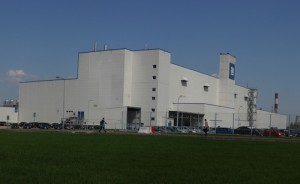GM stays tight-lipped over plans for production in St Petersburg
 GM has declined to comment on suggestions that production at its plant in St Petersburg could restart by the end of the year.
GM has declined to comment on suggestions that production at its plant in St Petersburg could restart by the end of the year.
Comments made recently by policymakers in Russia and Belarus, however, suggest the lines could start rolling again by the end of this year or early in 2017 – although it may not be making GM-branded vehicles and could be under the management of a different company, it seems.
“I think that before the end of the year, there will be a move associated with the re-commissioning [of car assembly] at the GM plant, but only in a different format; and they will start with the production of light vehicles,” said Maxim Meyksin, head of St Petersburg’s Committee on Industrial Policy and Innovation, recently – raising the possibility that assembly could restart with vehicles that were not a GM brand.
First deputy minister of industry for Belarus, Gennady Svidersky, meanwhile, claimed that from the second quarter of 2017, GM St Petersburg might come under the management of Belarus carmaker Unison and could start assembling the Cadillac there. Belarus is in the customs union uniting it with Russia and Kazakhstan and last year, GM was reported to be moving production of the Escalade and Tahoe from semi-knockdown kits (SKDs) from St Petersburg to Unison’s Minsk plant in Belarus, though this was never confirmed.
Back in 2015, when GM decided to shut down production of cars at the plant, Meyksin said the carmaker would probably return to the market within two to three years.
Following the closure of the plant last year, there was some speculation in the Russian press about the possible restoration of car assembly at GM. Unnamed insiders were quoted claiming that GM had refused to sell its plant to an interested investor at the time.
GM has refused to confirm or deny these suggestions, however, or to comment on the latest claims by Meyksin and Svidersky.
“The plant remains our property and while there are not any movements, we do not have any statements with regard to its operational status,” said GM’s spokesperson in Russia, Sergei Lepnuhov.
There remains an industry-wide belief, however, that GM will return to Russia, following recent government forecasts on economic recovery and its predicted impact on car sales for 2017 and 2018.
According to Andrey Ivoylov, co-owner of automotive dealership R Motors, which used to sell GM models, that return to the market could take place in the form of a joint venture, a set-up that would allow GM to share the risk of returning.
“There is not much sense in opening any new venture without getting tax benefits, as it is easier to import cars instead of this. This is what GM said it was doing when it closed the plant in 2015, importing premium Cadillac and Chevrolet products, such as the Corvette, Camaro and Tahoe,” said Ivoylov.
Backing up Svidersky's point, Ivoylov said that the St Petersburg plant could start assembling the Cadillac again but from imported SKD kits and in small volumes of between 2,000-3,000 a year. He also suggested GM could launch assembly of cars made by the UZ-Daewoo plant and, in particular, the Ravon brand.
“The recipient of the benefits, under the agreement [on industrial assembly] with the Ministry of Industry, can be only be GM, but a joint venture might also work with this,” said Ivoylov.
Michail Chaplygin, CEO of fellow dealership Auto-Dealer-SPb, offered a similar opinion about the production of Ravon vehicles at the plant. According to him, given the price of the car, it would be feasible to produce it in volumes as low as 50,000 cars per year.





